Cross-Functional Collaboration: The Secret Of Top-Performing Marketing Teams
Cross-Functional Collaboration happens when team members from different departments / business units join forces on a project or contribute to a common process.
In other words:
It is when a group of individuals with different skill sets comes together to achieve a common goal.
Kind of like building your own Avengers-style task force:

Your cross-functional team can be made up of people from all levels and areas of your organization; if their skills are relevant to achieve the goal, they are a welcome addition.
This type of collaboration, when done correctly, can lead to higher levels of innovation, creativity, and achievement.
So, how can your marketing team benefit from such a setup?
Excellent question.
By assembling people from your:
- Product team
- Sales team
- Legal team
- HR team
- Marketing team
- Agency team
You can build an all-star team that supercharges your (social media) marketing strategy & execution.
In this guide, we are going to look at how you can leverage cross-functional collaboration to build a more accurate, well-rounded and effective brand on social media.
Let’s get stuck in…
Table of Content
- Product Team: keeping you accurate and informed
- Sales Team: focusing on the customer
- Legal Team: anticipating risk
- HR Team: building a strong employer brand
- Other Marketing Teams: creating innovative cross promotion
- Agency: extending collaboration beyond your organization
1. Product Team: Keeping You Accurate And Informed

A product team member is your real-time connection to the product.
Note: “product” in this case means anything your company sells. Cross-functional collaboration can be used no matter what your end-product is.
From a marketing perspective, your product team member can:
- Fact-check product information in your social media posts
- Provide information about upcoming product releases
And, at your end of the bargain:
You can share real-time feedback you gather from social media to help shape future product iterations:
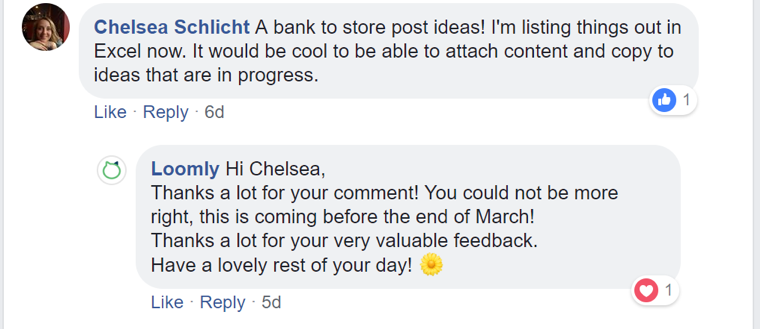
Your product team can also provide valuable insights that result in high-quality content.
We recently collaborated with our product team to create a series of short tutorials to assist our existing customers in their journey with Loomly:
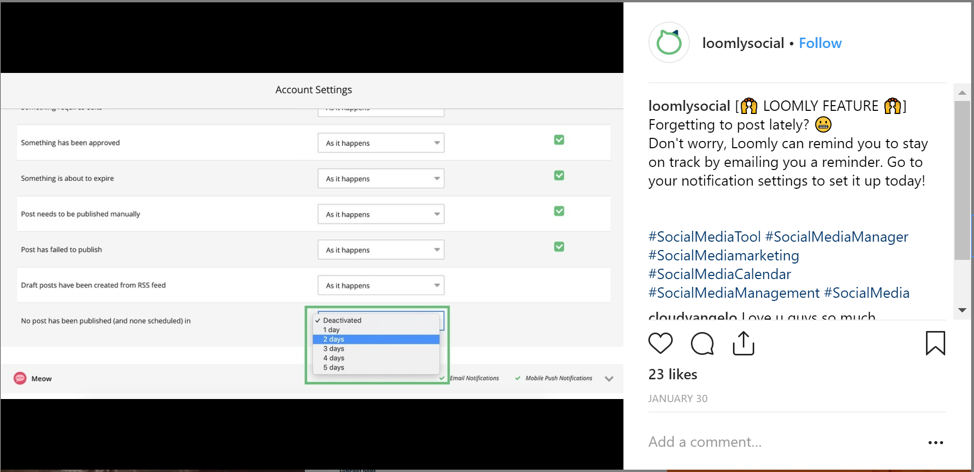
Having a product team member on board also enables you to quickly and efficiently handle product queries.
You can simply get in touch (or pop to their office) to get an accurate answer, then swiftly respond:
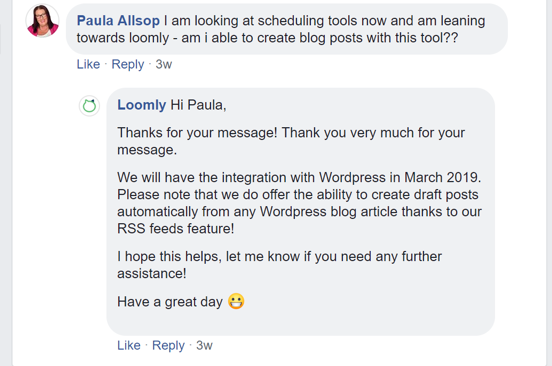
Another way to handle this would be to give them direct access to your social media accounts.
You can achieve this by creating a unique login for each of your accounts, or by using a social media management tool like Loomly, where you can do it all from one easy-to-use dashboard.
There are four steps in your social media workflow where you should include your product team:
- Inspiration: generate ideas for the coming cycle
- Review and approval: have them look at your updates before posting
- Community management: to share product queries
- Learning and optimization: share any feedback you have received
Potential Caveat & Workaround
It is not unusual for different teams to have different goals.
Having a bias towards a team’s goal can cause friction and hamstring opportunities for innovations.
To combat this, we recommend establishing a well-defined common goal for this (cross functional) collaboration that both teams can work towards, independent of their current goals.
For example, instead of trying to get the product team to adopt your social media goals, create a standalone goal like, “create 10 pieces of visual product-focused content each month”.
2. Sales Team: Focusing On The Customer

A sales team member is your direct connection to your organization’s customers.
The best way to collaborate with your sales team is by sharing information:
- They provide you with from-the-field feedback.
- You share sales queries and new leads with them.
The feedback they give you can have lots of positive benefits on your social media strategy.
How?
By giving you:
- The information you need to create accurate customer personas. This can help you to create and curate more targeted social media posts.
- A deeper insight into your followers’ wants, needs, and desires. Meaning you can add emotional triggers to your content that improve your reach.
- Exact phrases used by your customers to use in your copywriting. This is a powerful technique used to create compelling online content.
- Testimonials to use in your updates. Customer-driven stories can increase social proof, and lead to more effective brand storytelling.
- Qualitative data about customers who were influenced by social media, and insights about what aspects were most effective or persuasive.
On the flip side, you can provide them with a stream of leads they would not otherwise be able to find.
For example, if you receive social media messages about sales (or even sales objections), you can flag them and pass them on to your sales teams.
We have made this easy for your in Loomly with Interactions:
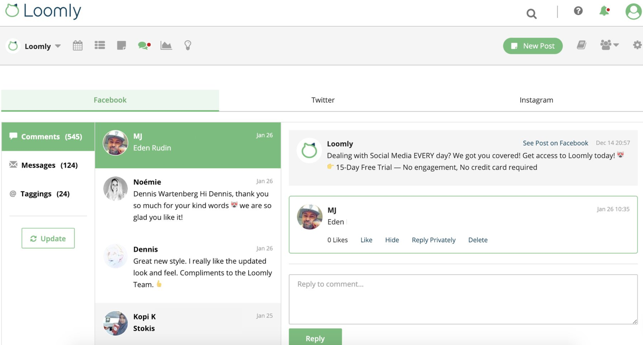
Here again, there are four steps in your workflow where you should collaborate with your sales team members:
- Inspiration: generate ideas for the coming cycle
- Review and approval: ask them to review sales messages in your updates
- Community management: to share any leads generated
- Learning and optimization: ask them to provide feedback they have received from the last period
Potential Caveat & Workaround
The marketing and sales team are working towards the same goal; you both want more people to buy your product.
Friction between these two teams often comes when you get into the nitty-gritty of implementation.
Sales team members often want to take an income-based approach to ROI, while marketers will use other metrics to measure the impact of a social media strategy.
For cross-functional collaboration to succeed, it is important that both teams are educated on the current goals, tasks, and expectations of each team. And, you focus on areas where you can help each other the most.
“Effectively, change is almost impossible without industry-wide collaboration, cooperation, and consensus.” – Simon Mainwaring
3. Legal Team: Anticipating Risk

We are sure you will agree with us when we say:
When it comes to legal matters, it is better to prevent than cure them.
A legal team member helps you to anticipate and mitigate potential risks well in advance.
They can check your updates to ensure your content is compliant and catch any potential problems like:
- Industry regulation breaches
- Copyright issues
- Image usage
- Intellectual property
- Defamation
- Harassment
Cross-functional collaboration with the legal team is usually done in the review and approval stage of your social media workflow.
It is best practice to ensure the legal team has seen, reviewed and approved all your updates before they go live on any of your social channels.
This is true for all brands & businesses, and even more so for public companies — don’t you agree, Elon?
Potential Caveat & Workaround
Because your updates need to be reviewed and approved, the legal team can often become a bottleneck in your scheduling process.
To make this process more efficient, we recommend:
- Establishing an agreed turnaround time for updates
- Creating content well in advance
- “Batch” reviewing content for multiple cycles
- Having pre-approved “backup” updates
4. HR Team: Building A Strong Employer Brand

An HR team member can help you to build a strong employer brand.
When done correctly, cross-functional collaboration with your human resources team can contribute to attracting top talent to your company.
Ideally, this collaboration will focus on:
- Crafting an effective employer narrative
- Finding and sharing employee-focused stories
- Innovating ways to connect with top talent on different platforms
The ins and outs of employer branding are a little beyond the scope of this article. So, we do recommend you take a look at your definitive guide to employer branding here.
Your approach to employer branding will dictate how you collaborate.
If you are incorporating employer branding into your current publishing process, then you will want to include the HR team at these stages:
- Inspiration
- Review and approval
- Learning and optimization
However:
If you plan to create a standalone employer branding channel with its own platform, then you will likely want the HR team to be involved at every stage of the process.
Potential Caveat & Workaround
HR and marketing are two inherently different divisions. This means there will be terminology, jargon and even world views that create misunderstandings.
When entering into collaborations, it is worth taking the time to understand the other team’s current tasks, job roles, and jargon to avoid any “culture clash”.
5. Other Marketing Teams: Fostering Innovative Cross Promotion

It can also be effective to collaborate with different marketing teams within your organization.
Let’s say you work for Nike, and your division handles the marketing for running apparel.
You could collaborate with members of the marketing teams for:
- Sports: Football, baseball, basketball, soccer, etc.
- Fashion: Men’s, women’s, and children’s
- Events: Conventions, sponsored marathons, online events, etc.
To create an innovative marketing strategy across the brand.
Likewise, you could also develop a marketing team from the different styles of marketing to develop a broader marketing strategy.
Depending on your company’s size, you may have in-house:
- Content marketing teams
- Search marketing teams
- Direct mail marketing teams
- eCommerce marketing teams
- Loyalty marketing teams
Who all have different perspectives and data-points driving their decision making and campaigns.
“Collaboration allows us to know more than we are capable of knowing by ourselves.” – Paul Solarz
It could be that you share:
- Insights from your global marketing teams to see what types of content perform well in different countries
- Social media insights to inform the content your search marketing team creates
- Data from your loyalty marketing team to create online offers
The driving force behind this type of cross-functional collaboration is communication between departments. After all, a siloed marketing team is constantly fighting an uphill battle.
When you can get members of different teams to share, generate ideas and inspire each other, you can improve your efforts on all channels.
Potential Caveat & Workaround
It can be hard to convince other departments to take on more projects.
It is important to set clear, realistic expectations and time commitments so the collaboration between teams becomes more manageable. (And not just another mammoth task at the end of a to-do list!)
6. Agency: Extending Collaboration Beyond Your Organization

The final type of cross-functional collaboration we want to discuss is with an agency that behaves as part of your in-house team.
It could be that many chunks of your process, especially those like:
Are outsourced to a third-party agency.
Although this is a great strategy for many organizations, it can also:
- Increase the number of siloed teams
- Reduce communication between teams
- Result in off-brand messaging
- Slow innovation
- Restrict creativity
Collaboration between your two teams, then, is essential to alleviate these symptoms.
Potential Challenges
An agency will already have a well-established was of operating. Their systems, processes, and even tools will be well-engrained and even habitual.
This makes it important to start new collaborations at a place that is easily accessible and manageable for both teams.
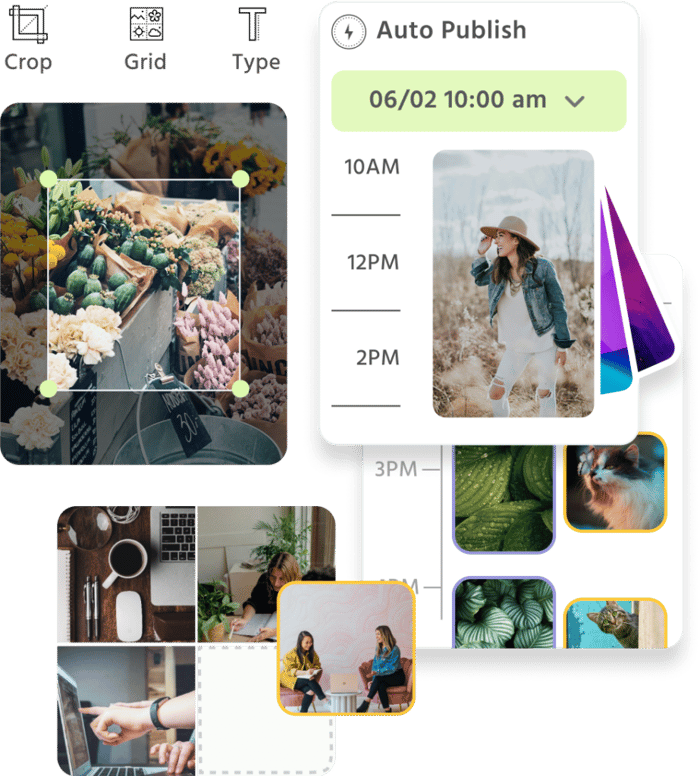
Manage all your social media accounts in one place.
Craft, schedule, & auto-post content to all your social channels, then track analytics and manage interactions from a single, easy-to-use dashboard.
Wrapping This Up!
Cross-functional collaboration has lots of benefits to your organization.
“No matter how brilliant your mind or strategy, if you are playing a solo game, you will always lose out to a team.” — Reid Hoffman
When you remove silos and open communication, you are able to create a positive culture around innovation and creativity.
There may be challenges along the way, but the end result for both you and your customer will be — much — better over the long term.
Speaking of challenges…
Did you know Loomly can help you improve communication, reduce bottlenecks and optimize your workflows?
By giving you everything you need to collaborate in one social media management platform, you can work seamlessly with your cross-functional team, while getting the data you need to make informed decisions.
You can try Loomly free for 15 days: start here.



